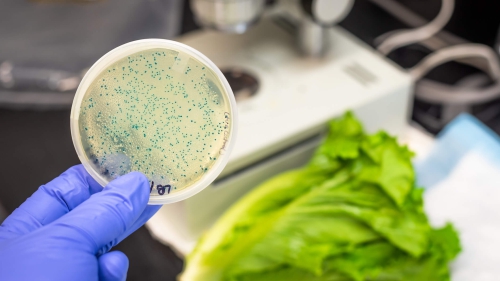Lactose Intolerance

Lactose intolerance is a common culprit for digestive dilemmas in many individuals. Lactose is the sugar naturally present in dairy products. Once consumed, it must be broken down by the intestinal enzyme lactase. Primary lactose intolerance is the most common form of the condition. It is due to a deficiency of the lactase enzyme. Lactase activity is highest in newborns and declines after weaning around age two. Symptoms may begin to appear in adolescence or early adulthood. Affected individuals complain of abdominal pain, bloating, gas, or diarrhea after consuming products containing lactose. Products with lactose need to be limited or avoided in some cases. The following infographic illustrates the process:

Who is Affected?
While some individuals are born with a lactase enzyme deficiency, 65 percent of humans become lactose intolerant after infancy, according to the National Institutes of Health. The prevalence is higher in East Asians, Native Americans, and Africans and much lower in Europeans, partly due to the history of milk product consumption of these communities. Individuals that frequently consume milk and dairy products may have lactase persistence, which allows them to digest lactose into adulthood successfully. Communities with a higher prevalence of the condition can try to gradually increase their consumption of lactose to build up their tolerance.
Some individuals have different forms of lactose intolerance:
Secondary lactose intolerance is caused by intestinal disorders like Crohn's disease, ulcerative colitis, or Celiac disease and radiation therapy for cancer treatment. These are all known to cause damage to the lining of the intestines, which significantly interferes with lactose absorption. This type of lactose intolerance often resolves once the underlying cause is treated.
Developmental lactose intolerance is seen in babies born prematurely. A baby’s small intestine creates cells producing lactase at the end of the third trimester of pregnancy. Babies born early may not have fully developed this enzyme though this generally resolves soon after birth, and babies can tolerate lactose-containing formulas and breastmilk.
Congenital lactose intolerance is a more rare form of the condition. The baby will develop this condition if both parents have mutations in the LCT gene, which instructs the body to make lactase enzyme. In this case, the baby cannot tolerate breastmilk or regular infant formula, as this will cause excessive diarrhea and dehydration. They must be fed a lactose-free formula. Whether or not they need to limit lactose consumption into adulthood depends on genetic variations. Some variations will allow lactase production, and others will not, so the diet must be adjusted accordingly.
What Dairy Products are Involved?
Lactose intolerant individuals can usually tolerate up to 12 grams of lactose per day. It helps if this is spread out into small amounts.
| Product | Serving Size | Lactose Content (Grams) |
| Evaporated milk | 1 cup | 24 |
| Milk
(whole, 2%, 1%, skim, regular, chocolate, buttermilk) |
1 cup | 10-12 |
| Nonfat dry milk | ⅓ cup | 12 |
| Ice cream | ⅔ cup | 8 |
| Greek yogurt | 6 oz | 6 |
| Condensed milk | 2 tbsp | 5 |
| Cottage cheese | ½ cup | 4 |
| Cheese | 1 ounce (size of a domino)
1 pre-cut slice |
2 |
| Cream cheese | 1 ounce (size of a domino) | 1 |
| Butter | 1 tsp | Trace amounts |
Hidden Sources of Lactose
![]() Whey protein powders (choose whey protein isolate for the lowest lactose content)
Whey protein powders (choose whey protein isolate for the lowest lactose content)
![]() Some bread
Some bread
![]() Baked goods
Baked goods
![]() Pancake mix
Pancake mix
![]() Ready-to-eat breakfast cereals
Ready-to-eat breakfast cereals
![]() Hot chocolate mix
Hot chocolate mix
![]() Instant soups
Instant soups
![]() Instant mashed potatoes
Instant mashed potatoes
![]() Puddings
Puddings
![]() Candies and cookies
Candies and cookies
![]() Some salad dressings
Some salad dressings
Practical Tips for Reducing Symptoms
![]() Introduce one new food for 2-3 days and monitor symptoms
Introduce one new food for 2-3 days and monitor symptoms
![]() Try having the new food in the morning first
Try having the new food in the morning first
![]() Start with a 4-ounce serving of milk
Start with a 4-ounce serving of milk
![]() Combine a small milk serving with a larger serving of another food (small glass of milk + fruit salad)
Combine a small milk serving with a larger serving of another food (small glass of milk + fruit salad)
Recommendations for Children
The American Academy of Pediatrics recommends giving children with lactose intolerance small amounts of dairy products regularly. Focus on Greek yogurt and aged cheeses first. As they safely tolerate these, increase the serving size. Then incorporate 4-ounce servings of milk with meals and monitor symptoms. Children should be able to tolerate these foods better with time and increased exposure.
Should I Look for Dairy-free Labels?
Not necessarily. Those with a milk allergy need to choose dairy-free foods because their bodies will produce a dangerous allergic reaction to milk products. Lactose intolerant individuals can tolerate milk products, but the serving size must be small. Become familiar with items containing high levels of lactose (use the above table). When shopping, look for these items in the ingredient list. Individuals may prefer to avoid milk products, but with proper planning, these can be safely incorporated into the diet.
Milk Alternatives
There are several products available if you choose to avoid cow's milk due to persistent discomfort or are simply looking for new options. Organic Valley® is a popular brand that offers lactose-free milk products. Individuals can choose the lactose-free milk or the ultra-filtered milk. The former has been treated with lactase enzyme to convert the lactose while the latter is filtered to remove the lactose, making digestion much easier on the body. Organic Valley milk products are also halal certified by IFANCA. Other options include soy milk, nut milk, oat milk, and coconut milk.
Meeting Calcium Needs
Adults need 1,000-1,200 mg of calcium daily. A serving of milk or yogurt contains 300 mg of calcium. Three of these servings would bring you close to the recommended amount. Those with lactose intolerance can build up to this amount gradually. Organic Valley lactose-free milk contains about the same amount of calcium as cow's milk. Alternative milk such as those made from soy and nuts are also calcium-fortified (check the label, some varieties may not be fortified).
Greek Yogurt is Better Tolerated
Greek yogurt is strained, so the whey (liquid) portion containing much of the lactose is filtered out. The live active bacterial cultures also eat some of the remaining lactose, so digestion becomes easier. Regular yogurt also contains live active bacterial cultures and can also be a good choice.
Nutritional Supplements
Nutritional supplements like Ensure® are made with milk ingredients, but the lactose content per serving is 0.5 grams, which is clinically insignificant. (Ensure is halal certified by IFANCA.) In practice, most of my patients have tolerated these products well though some still complained of abdominal distress. The complaints could be multifactorial. Other components in the drink, such as the simple sugars, can cause bloating and diarrhea, which is more likely to happen in individuals who have malabsorptive conditions or irritable bowel disease. A good approach would be to try half a bottle at a time and monitor symptoms. If tolerated, increase the serving size and monitor again.
Closing Thoughts
Managing symptoms often becomes overwhelming for individuals with lactose intolerance, which often prompts the decision to avoid dairy products altogether. Some individuals may decide to do this by preference, but it is possible to incorporate dairy into the diet. Learning the lactose content of foods is imperative. Be sure to look at the serving size on food labels. The amount listed may be very different from the amount you will consume. Lastly, the most time-consuming part is trial and error. It helps to keep a small notebook in your kitchen to write down the lactose-containing foods you ate and a summary of your symptoms. Building up lactose tolerance requires the introduction of these foods in small amounts to allow your body and intestinal bacteria to adapt to the changes. Patients often tell me that the "problem foods" were only a problem in larger amounts. Once they reduced the serving size, they felt much more comfortable. Lactase drops are appealing to consumers as an easy, cost-effective way to enjoy dairy again. They are added to regular dairy products, and the enzyme breaks down the lactose for you. Some individuals benefit from lactase tablets. These are available over the counter and are taken thirty minutes before meals and snacks. Using lactase tablets should be discussed with your primary care physician if the discomfort does not resolve, and symptoms persist over time.
Summaya Ali holds a Master’s degree in Nutrition from the University of Illinois and is a Registered Dietitian. She is excited to begin her career in Dietetics.
Reprinted from the Summer 2020 issue of Halal Consumer© magazine with permission from the Islamic Food and Nutrition Council of America (IFANCA®) and Halal Consumer© magazine.

















